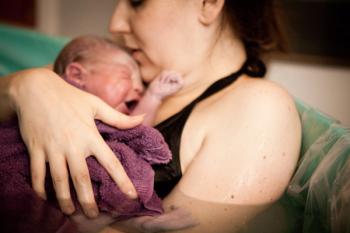
Exencephaly – Anencephaly Sequence and its Sonographic Features
Anencephaly represents the most common neural tube defect. It’s incidence is approximately 1:1000 with female predominance (4:1) and geographical variability.
Introduction
Anencephaly represents the most common neural tube defect. It’s incidence is approximately 1:1000 with female predominance (4:1) and geographical variability.1,2 The etiology of anencephaly closely mirrors that of spina bifida. The condition results from the failure of the rostral (cephalic) neuropore to close. Sonographic as well as pathologic evidence points to a close link between exencephaly (also frequently referred to as "acrania") and anencephaly. It has been proposed that the brain tissue of exencephalics may gradually degenerate due to the exposure to amniotic fluid in combination with mechanical trauma. This wearing down of the brain stroma produces the classic anencephalic features with flattened brain remnants behind the prominent orbits. This hypothesis is supported by animal studies, pathologic analysis of exencephalic brain stroma when compared with cerebrovasculosa2, as well as observations on ultrasonography combined with amniotic fluid cytology. 3
Ultrasound Findings
Reliable sonographic diagnosis of anencephaly is usually possible in early second trimester (10-14wks GA) 4. Conventional 2D ultrasound is accurate in diagnosing anencephaly5 and the sensitivity is virtually 100% after 14wks GA6. 3D sonography has been shown to be equally effective in detecting anencephaly. 7
On ultrasound, the cranial vault (bony calvarium) is symmetrically absent. Rudimentary brain tissue (area cerebrovasculosa) is covered by a membrane, but not bone (Figure 1,2). This be seen protruding from the base of the skull in the early second trimester, and gradually degenerates until the appearance of the head is completely flattened behind the facial structures. Facial views reveal frog-like appearance with prominent bulging eyeballs (Figure 3,4). Associated polyhydramnios usually develops in the second trimester and is likely due to absent or ineffective fetal swallowing (Figure 3). High degree of fetal activity is often observed. 1,2,6
Figure 1
Sonographic pitfalls in the diagnosis of anencephaly usually revolve around difficulties in imaging such as vertex presentation with deep head location. 1,2 Differentiation of anencephaly from severe microcephaly or large encephaloceles can also be difficult, but in these conditions the cranial vault is always present.6,8 Amniotic band syndrome associated with cranial disruption(s) may also mimic anencephaly. 2,6 Finally, inexperienced operator may confuse the angiomatous stroma with normal fetal calvarium in the early second trimester. Therefore, identification of the fetal head does not rule out anencephaly.8
Conclusion
The prognosis of anencephaly is dismal with live newborns invariably dying shortly post delivery. Termination of pregnancy is usually offered regardless of the gestational age. Anencephalic fetuses have been considered as potential organ-donors, however the ethical considerations in these cases are still under debate. 9
Figure 5
Acknowledgment
Special Thanks to: James E. Maher, M.D. (Center of High Risk Pregnancy, Pensacola, Florida) for his assistance in this case.
References:
Citation: NecasM, DuBoseT, TaylorV: "Exencephaly -Anencephaly Sequence and its Sonographic Features". June 2000;
References
1) Romero R, Pilu G, Jeanty P, et al: Prenatal Diagnosis of Congenital Anomalies. Appleton & Lange, Norwalk. 1988; p43-5.
2) Nyberg DA, Mahony BS, Pretorius DH: Diagnostic Ultrasound of Fetal Anomalies: Text and Atlas. Mosby Year Book, St. Louis. 1990; p149-52.
3) Timor-Tritsch IE, Greenbaum E, Monteagudo A, Baxi L: Exencephaly-anencephaly sequence: proof by ultrasound imaging and amniotic fluid cytology. J Matern Fetal Med. 1996 Jul-Aug;5(4):182-5.
4) Johnson SP, Sebire NJ, Snijders RJ, et al: Ultrasound screening for anencephaly at 10-14 weeks of gestation. Ultrasound Obstet Gynecol. 1997 Jan;9(1):14-6.
5) Isaksen CV, Eik-Nes SH, Blaas HG, Torp SH: Comparison of prenatal ultrasound and postmortem findings in fetuses and infants with central nervous system anomalies. Ultrasound Obstet Gynecol. 1998 Apr; 11(4):246-53.
6) Rumack CM, Wilson SR, Charboneau JW: Diagnostic Ultrasound. Second Edition vol 2. Mosby, St. Louis. 1998; p1260-2.
7) Yanagihara T, Hata T: Three-dimensional sonographic visualization of fetal skeleton in the second trimester of pregnancy. Gynecol Obstet Invest 2000;49(1):12-6
8) Callen PW: Ultrasonography in Obstetrics and Gynecology. W.B. Saunders Company, Philadelphia. 1994; p219-21.
9) Walters J, Ashwal S, Masek T: Anencephaly: where do we now stand? Semin Neurol 1997;17(3):249-55.
Newsletter
Get the latest clinical updates, case studies, and expert commentary in obstetric and gynecologic care. Sign up now to stay informed.















